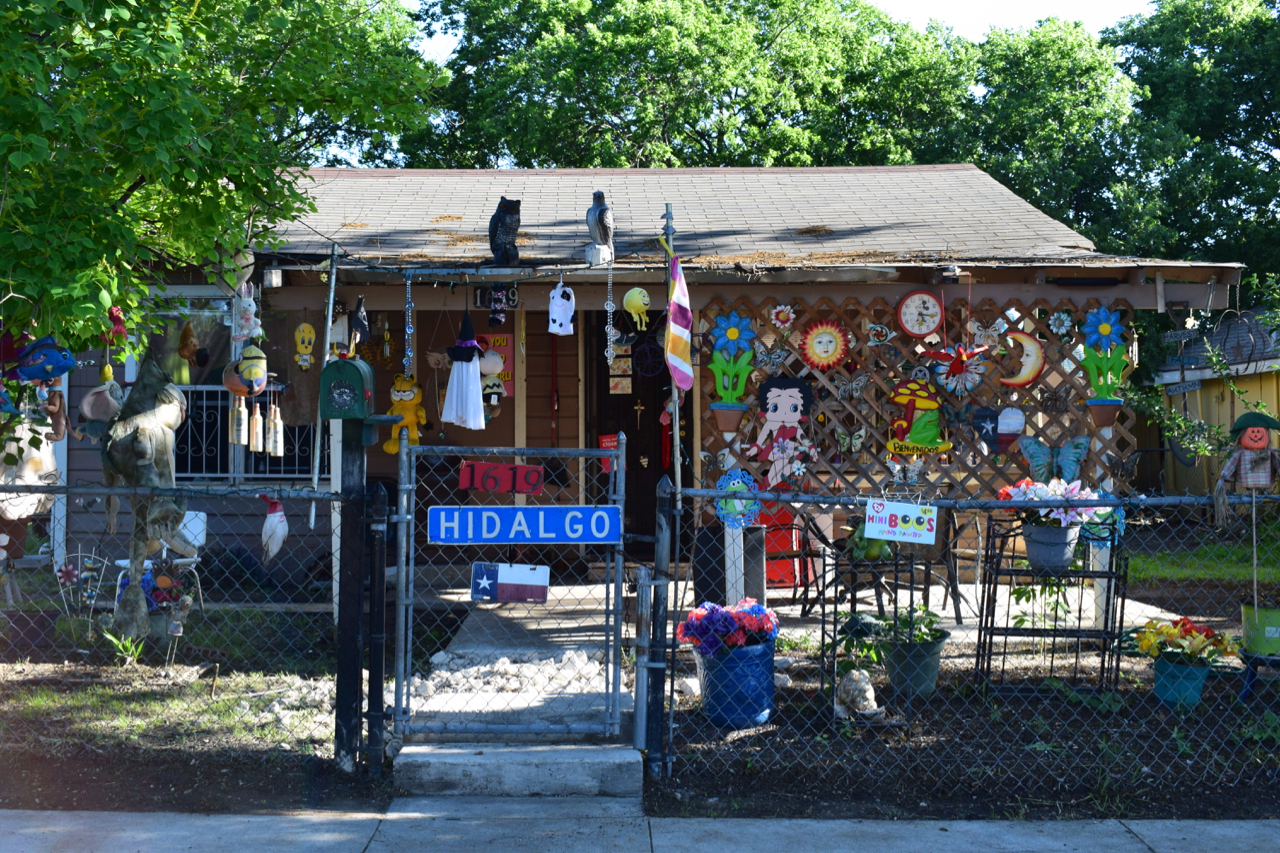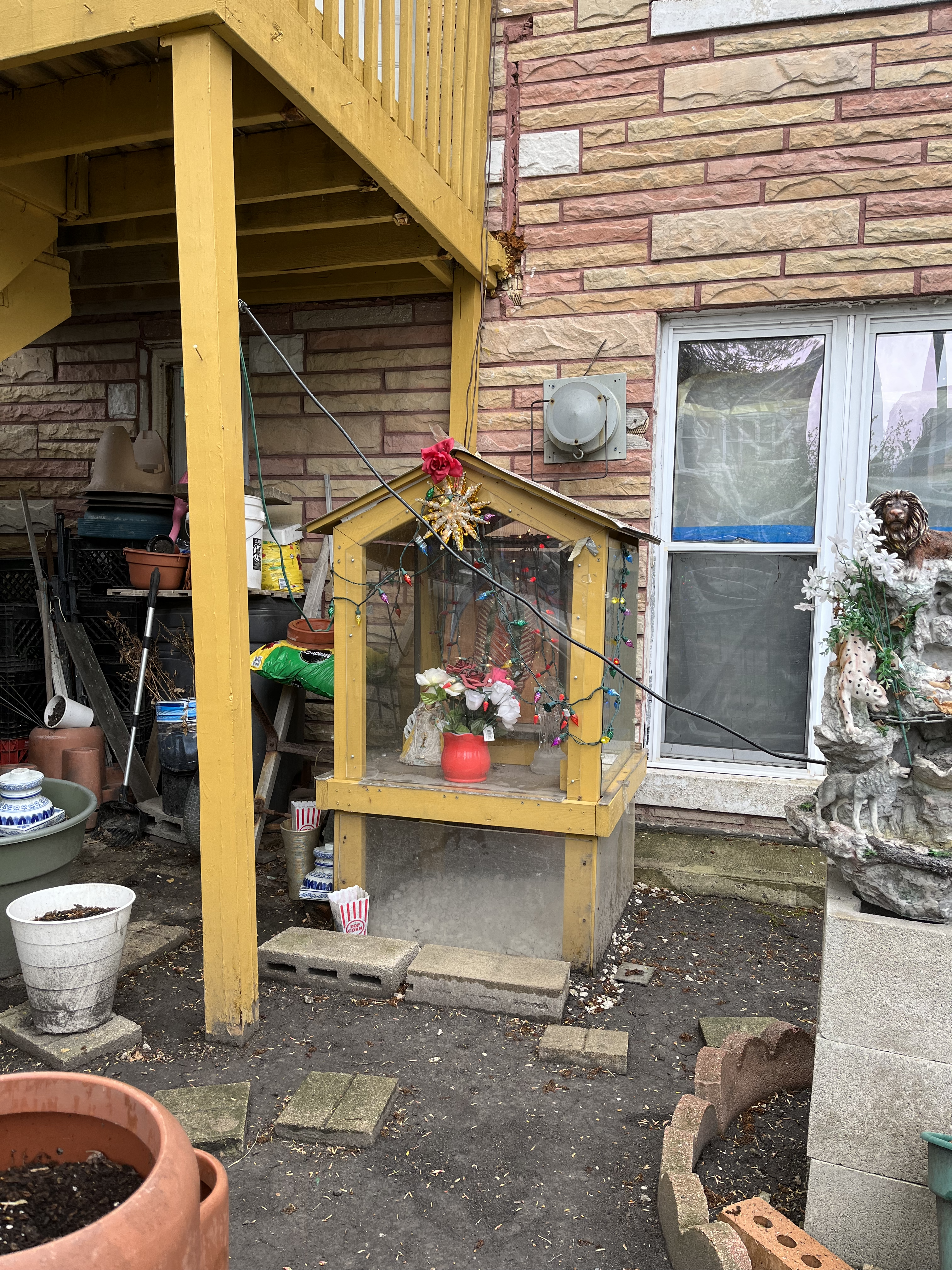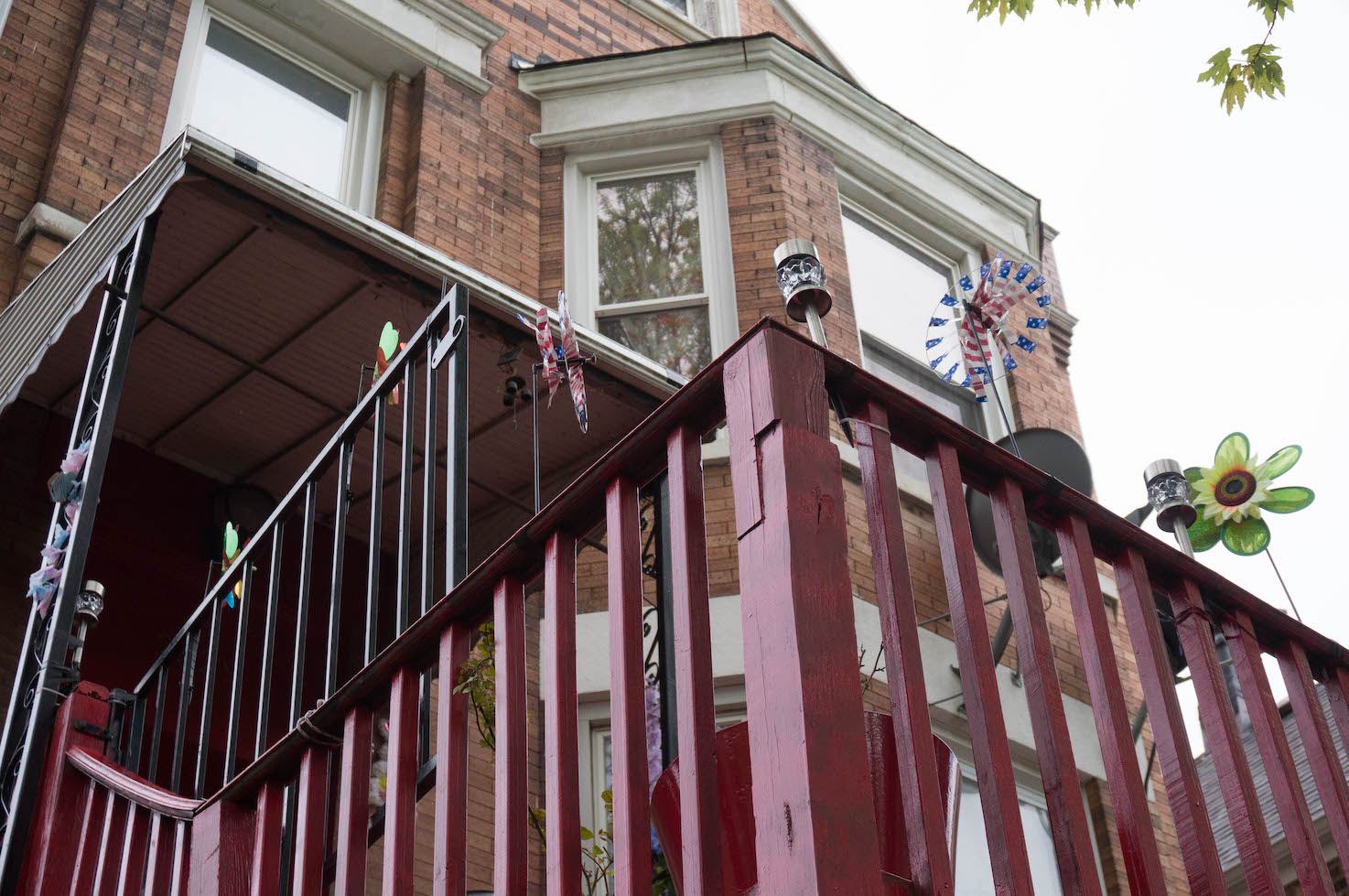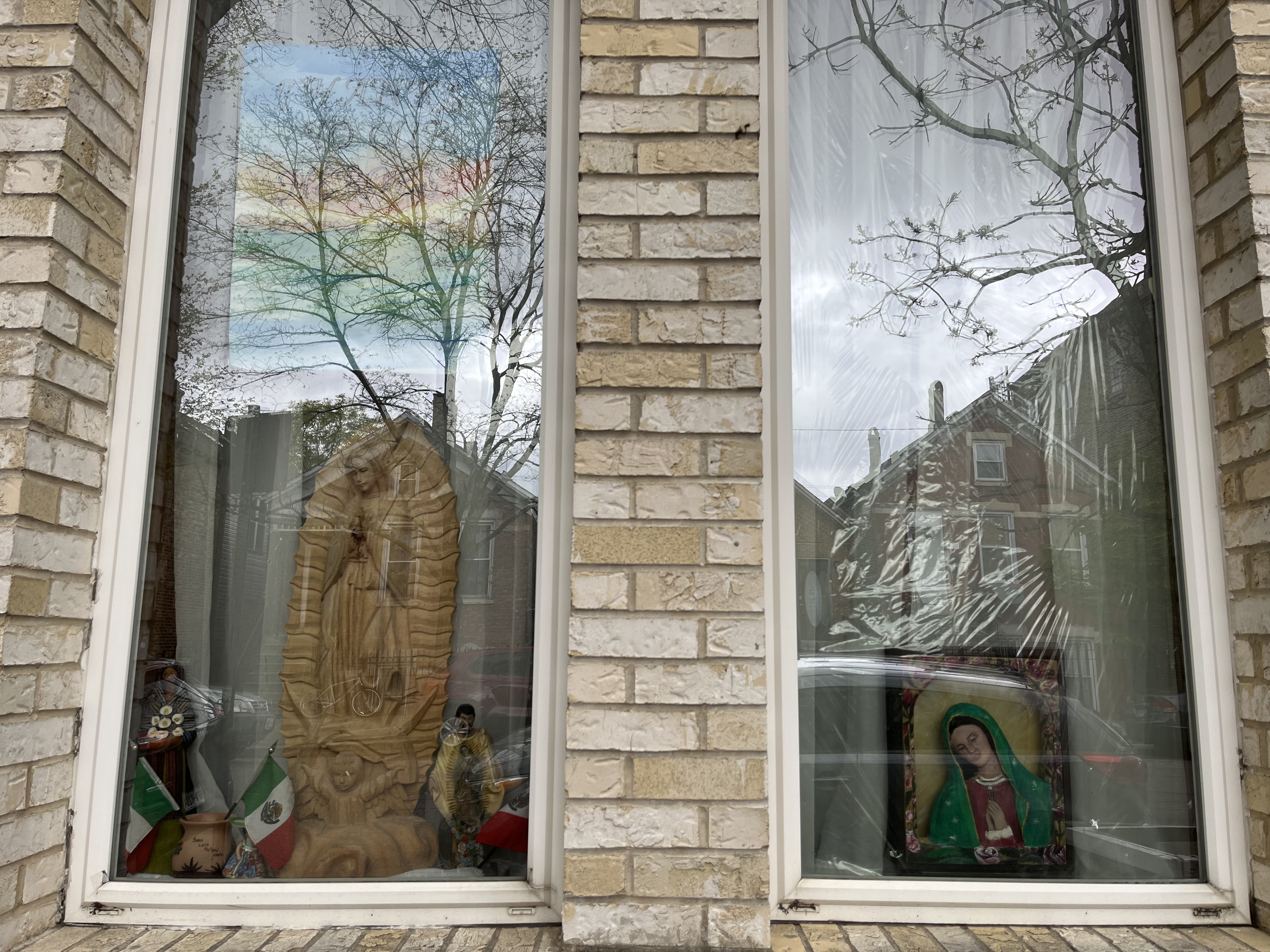DATE↓
STORY TYPE↓
AUTHOR↓
Domestic settings that embrace rasquachismo simultaneously claim space and build communal knowledge. Why aren’t more architectural historians looking into it?

In 2006, as an undergraduate studying Christian sites and relics, I was taken by acts made in the name of transmission: embarking on long pilgrimages to find healing from sites of martyrdom; viewing bodies, clothing, or hair from virtuous beings past to receive their miracles; bringing home statuettes of saints to pass on their powers to family. We preserve these sacred rituals so that they might continue imparting their wisdom, yet these items and expeditions are made by humans and could, in another time or context, be considered commonplace.
I still find myself thinking about ordinary objects and actions made significant—not by religious events or holy men, but by everyday people. Lately I’ve been drawn to the notion of rasquachismo, a word (pronounced ras-kwa-cheese-mo) with many Spanish translations. Much of rasquachismo literature indicates that it describes an attitude, an ethos, while its root word, rasquache, describes something “vulgar, poor, or of a lower quality, status, or value,” as scholar Laura G. Gutiérrez puts it in an essay about the subject. For her, rasquache is also “associated with a person who has some of these characteristics and who is resourceful and creatively inventive out of a necessity to make do.”
Most Chicano or Latine Americans, and those who have spent time in Latine communities, will recognize the rasquachismo aesthetic: It regularly appears on the home front, both privately and publicly, where making do manifests as houses painted in bright colors, reusing coffee cans as flower planters in backyards, and plentiful interior decorations made from quotidian objects, among other D.I.Y. embellishments. But it can also be elderly women chatting on their stoops or the neighborhood watch, as poet and cultural activist Roberto Bedoya argues in his 2014 essay “Spatial Justice: Rasquachification, Race and the City.”
All these interpretations are valid, and share a throughline that is perhaps most palpable in domestic settings: Rasquachismo, as I’ve come to understand it, is a means for the underdog to build civic power. It is a quality built of grit and space, and it is assertive not only in its color or material accumulation, but through its transmission.

Though rasquachismo has a recognizable appearance, its definition is slippery. Who’s saying the word and to whom, and about whom, determines the word’s meaning. Chicano studies scholar Tomás Ybarra-Frausto has penned several essays about rasquachismo, including his famous “Rasquachismo: a Chicano Sensibility” (1989), which paints a vivid portrait.
“To be rasquache is to be unfettered and unrestrained, to favor the elaborate over the simple, the flamboyant over the severe,” he writes. “In the barrio, the environment is shaped and articulated in ways that express the community’s sense of itself, the aesthetic display projecting a sort of visual biculturalism.” To him, any number of objects, acts, or relationships could be rasquachismo: “Sometimes I think that all Chicanos are rasquache except you and me, and sometimes I wonder about you!” Slippery, indeed.
Also layered into the term is its connection with a working-class sensibility. Curator and educator J. Gibran Villalobos, whose work for the National Museum of the American Latino Act informs the Smithsonian’s forthcoming National Museum of the American Latino, sees rasquachismo as directly connected to social status. “It’s a recognizable aesthetic only after we understand the circumstances that have led to it,” he told me. “When I think of rasquachismo, I might think about it as the socioeconomic conditions that lead us to make those choices that then are reflected in the aesthetics of what we see.”
That means that rasquachismo might look different depending on the city or region. It might change depending on, say, a pandemic, a recession, or an inflation crisis, shifting one’s capacity for making do.

But there’s something particularly powerful about rasquachismo when considered through the lens of where and how people live. The decorative aesthetic that manifests on houses and lawns—often on view for all eyes to see—becomes a means to transmit a socioeconomic condition outward, to claim space and to communicate the power of those conditions to outsiders. Something sacred, and monumental, is transmitted through rasquachismo.
It also transcends borders: While the complexities of the American Latino identity are shaped by their distinct origins—Dominican, Puerto Rican, Cuban, Mexican, and so on—rasquachismo unites them by transmitting the power of brownness. “Identity is a problematic term when applied to Latinas/os—groups who do not cohere along the lines of race, nation, language, or any conventional demarcation of difference,” the late Cuban American academic José Esteban Muñoz wrote in his posthumous book The Sense of Brown. But “feeling brown,” or being a problem, he continued, “is also a mode of belonging through recognition […]: Feeling an ‘apartness together’ through sharing the status of being a problem.”
This perspective resonates with art historian Deanna Ledezma, who told me that rasquachismo is a “silent nod or communication” to others, a way to create a sense of belonging in spaces where identity is fraught. Ledezma studies domesticana, a Chicana version of rasquachismo, and notes how artist and curator Amalia Mesa-Bains defines it: as a feminist practice primarily done at home—a place, Ledezma says, that Mesa-Bains “recognizes as being ‘both a palace and a prison,’ where women can assert power”—by claiming space through makeshift altars of everyday items and the more public capilla, or small chapels.
Domesticana has traditionally relied on exerting power in the home under patriarchal conditions, but, like rasquachismo, it results from shifting socio-economic conditions that produce the aesthetic. So as women’s economic and social power grew, domesticana made its way outside the home. Ledzema has explored this change through the work of Chicago-based photographer Diana Solís, and has also observed domesticana in intermediary spaces, like window sills. There, Ledzema says, “I saw little plants, flags, and religious shrines. It made me think about the window as this semi-public space, the most porous boundary between public and private.” In other words, these strategically placed altars are a public means of cataloging what happens in private, of transmitting information.
In this way, rasquache decor becomes a tool for building communal knowledge that can, potentially, be used to counteract the too-frequent displacement of brown communities. These silent nods, or as Villalobos calls it, “the squeaky wheel that raises the issues that are seemingly complicated by whiteness,” become a means to build agency and belonging in one’s block or neighborhood—and to fight to keep it.
Living in a time where, as architectural historian Kathryn O’Rourke has pointed out, rasquache neighborhoods are vanishing as a result of gentrification, static wages, and increasing housing costs, you’d think that rasquachismo would occupy a larger part of the vernacular. Why aren’t more architectural historians looking into the aesthetic to reflect on places like San Antonio, where most of its “‘high’ architecture,” as O’Rourke describes it, “was long influenced by Mexican colonial architecture and imagined by affluent patrons as somehow representing Mexican/Anglo bi-culturalism”? And imagine the new modes of understanding, she adds, that might be gained from thinking about buildings in a rasquache way. Too few are doing either. In American cities, rasquache is abundant. As with trees, we often fail to acknowledge phenomena that are right in front of us.

Bedoya, the poet and activist I mentioned earlier, is also a giant in the field of belonging. His work, which utilizes the terms placeknowing and placekeeping, opposes capitalist manifestations of urban interventions like placemaking. That term, he argues, is a project of the white spatial imaginary: policies, architectural projects, and laws created to racialize and dispossess marginalized communities. Placeknowing and placekeeping, however, help people orient themselves to their identities—who we are in relation to a particular space—and to maintain those identities.
“What is your relationship to your neighbors? What is your relationship to the folks coming out of the neighborhood bar?” he asked me a few years ago. “Those relationships are keeping you wanting to keep those things alive […], and to keep that sense of being is essential.” Muñoz, the late academic, called these connections the “brown commons”: the “feelings, sounds, buildings, neighborhoods, environments, and the nonhuman organic life that might circulate in such an environment.” But the qualities that make those elements brown, he pointed out, have the “potential for the refusal and resistance to often systemic harm.”
Villalobos, the curator, believes that brown commons’s resistance to white spatial placemaking is its reliance on rasquachismo’s constantly shifting socioeconomic conditions, making those commons particularly resilient to change. “Latino placemaking is better served when we think of it through the legacy of time, movement, migration,” he says. “What Latino placemaking tries to do is reference the expressive gestures that bubble up and then disappear. That’s why they’re so difficult to grasp onto.” It also makes those gestures difficult to demolish, diminish, or erase.
Today, I continually return to rasquachismo. Though it is a movement that doesn’t belong to me or my identity, my mixed heritage and brown skin are a problem. I am brown visually, but I am also brown in my feelings, in my relation to the world. Unlike the saintly relics or churches from my past studies, I painted my house purple as a means to transmit my existence, and my brownness, to the outside world. The altar in my home is a second-hand IKEA shelf with trinkets from my deceased grandmother’s travels. Rasquachismo’s ordinary exuberance transmits brownness as knowledge, as belonging, as a will to remain a problem—sacred in its own right to exist.